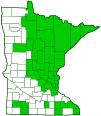rusty crayfish
(Faxonius rusticus)
Conservation • Description • Habitat • Biology • Distribution • Taxonomy
|
|
||||||||||||||
Description |
Rusty crayfish is an exotic, medium-sized to large, freshwater crustacean. It is native to Michigan, Ohio, and Kentucky. It is used extensively by fishermen as bait, and is sold as an aquarium pet. It has been introduced across the United States as unused bait and released aquarium pets. It is now found from Manitoba to Quebec in the north to Tennessee and North Carolina in the south, with disjunct populations in New Mexico and Oregon. There are large populations in many states, including Minnesota. It is considered invasive outside of its native range. Adults are about 1¾″ long when the reach maturity at one year of age. They live three or four years and continue to grow, molting at least twice a year, eventually reaching up to 4″ in length not including the claws. The legs, abdomen, and shield (carapace) covering the front part of the body (cephalothorax) are variable in color. They may be greenish-gray, reddish-brown, or tan. There is usually a rust-colored, thumbprint-like mark on each side of the carapace, and a rust-colored stripe on the upper (dorsal) side of the abdomen. The rust-colored markings may not be present on any individuals in some locations. The long spike-like extension of the carapace that projects forward between the eyes (rostrum) has slightly concave sides. The claws (chelae) are up to 4″ long. They are larger and more robust than those of any other Orconectes species. They often have black bands at the tip. The movable finger (dactylus) on the claw has an S-shaped margin. The gap on the claws when closed is oval. |
Size |
Total length: 1¾″ to 4″ |
Similar Species |
Habitat |
Shallow water in permanent streams, ponds, and lakes with rocks or logs for cover |
Biology |
Season |
Most active early spring to late fall |
Behavior |
They are active in daylight. They are extremely aggressive, out-competing and eliminating other crayfish species when introduced into a new site. |
Lifespan |
3 to 4 years |
Life Cycle |
Breeding takes place in September and October. Eggs are laid in April and May. Juveniles have a higher metabolic rate, eat twice as much, and develop much faster than native crayfish species of similar size. |
Juvenile Food |
Aquatic invertebrates and fish eggs at the bottom on the water body |
Adult Food |
Omnivorous and opportunistic. Mostly decomposing organic matter (detritus), but also aquatic plants, animals (especially snails), and insects; other aquatic crustaceans; algae; and fish eggs. |
Distribution |
||
|
Sources Helgen, J.C. 1990. The distribution of crayfishes (Decapoda, Cambaridae) in Minnesota. Final report submitted to the Nongame Wildlife Program, Minnesota Department of Natural Resources. 96 pp. Biodiversity occurrence data published by: Minnesota Biodiversity Atlas (accessed through the Minnesota Biodiversity Atlas Portal, bellatlas.umn.edu, 6/11/2025). Nonindigenous Aquatic Species (NAS) information resource for the United States Geological Survey |
|
| 6/11/2025 | ||
Occurrence |
||
Common in eastern Minnesota |
||
Taxonomy |
|
Superclass |
Multicrustacea (typical Crustaceans) |
Class |
Malacostraca (malacostracans) |
Superorder |
Eucarida (crabs, crayfish, shrimp, etc.) |
Order |
Decapoda (crabs, crayfishes, lobsters, prawns, and shrimp) |
Suborder |
Pleocyemata (crabs, lobsters, shrimp, and allies) |
Infraorder |
Astacidea (crayfishes and lobsters) |
Superfamily |
Astacoidea (Northern Hemisphere crayfishes) |
Family |
Cambaridae |
Genus |
Faxonius |
Until recently, this species was included in the genus Orconectes. In 2017 a comprehensive review and updated classification of all the species of crayfish of the world was published (Crandall, K. A., and S. De Grave. 2017). The genus Orconectes was split into two groups. Cave dwelling members remain in the genus Orconectes. Surface dwelling members were placed in the resurrected genus Faxonius. |
|
Subordinate Taxa |
|
|
|
Synonyms |
|
Cambarus rusticus Orconectes rusticus |
|
Common Names |
|
rusty crayfish |
|
Glossary
Carapace
The hard, upper (dorsal), shell-like covering (exoskeleton) of the body or at least the thorax of many arthropods and of turtles and tortoises. On crustaceans, it covers the cephalothorax. On spiders, the top of the cephalothorax made from a series of fused sclerites.
Cephalothorax
The front part of the body of various arthropods, composed of the head region and the thoracic area fused together. Eyes, legs, and antennae are attached to this part.
Rostrum
The stiff, beak-like projection of the carapace or prolongation of the head of an insect, crustacean, or cetacean.
Crayfish or Crawfish?
The taxonomically correct term for members of the superfamilies Astacoidea and Parastacoidea is crayfish. "Crawfish" is a southern dialectical variant of that word. It is commonly used in the United States and is accepted American English, but it is not used outside the United States.
Visitor Photos |
||
Share your photo of this crustacean. |
||
This button not working for you? |
||
Christa Rittberg |
||
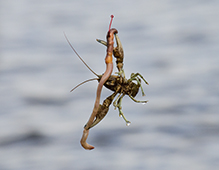 |
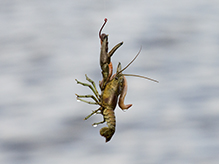 |
|
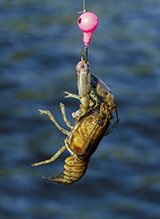 |
||
LMG |
||
Believed to be a Rusty Crawfish Young rusty crawfish found near chimney that they produce. ID based upon MN pollution control sight and larger exoskeletons found regularly nearby. Larger live specimens have been found a few years back. This one was about 2.5-3 inches long. |
||
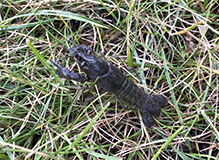 |
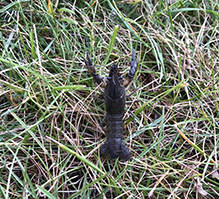 |
|
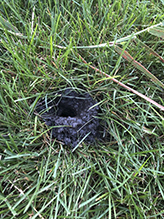 |
||
MinnesotaSeasons.com Photos |
||
|
||
|

Slideshows |
|

Visitor Videos |
||
Share your video of this crustacean. |
||
This button not working for you? |
||
|
Other Videos |
||
WDS - Rusty CrayFish of the Mississippi River |
About
Published on Aug 13, 2011 #1 Wildlife Documentary Series of Amazing Wildlife in Minnesota. This video is great for 3D Animators to do a walk cycle animation. Use this footage as a background in 3DS Max, ect. |
Straying Far From Home, Invasive Crayfish Threatens U.S. Waterways |
About
Published on Mar 10, 2011 Read the transcript: http://to.pbs.org/gIrXCA Vince Patton of "Oregon Field Guide" reports on the threat posed to waterways by the eastern crayfish, a species native to the Ohio River that can now be found in 18 states and two Canadian provinces. "Oregon Field Guide" is a production of Oregon Public Broadcasting. |
Rusty Crayfish - Orconectes rusticus - Hamilton County, Ohio, USA - December 1, 2012 |
About
Published on Dec 28, 2012 Filmed with underwater camera in the Little Miami River. |
Crayfish migration, Ontario, Canada |
About
Published on Oct 15, 2017 Possibly the first time a mass migration of crayfish has ever been filmed - under and above water! The invasive Rusty Crayfish Orconectes rusticus, has hybridized with a native Ontario species, Orconectes propinquus, and in several generations has evolved an overwhelming drive - an obsession - to migrate upstream. In the face of all odds, this crayfish is a compulsive pioneer! |
Know Your Invasives: Rusty Crayfish |
About
Published on Jun 4, 2013 University of Notre Dame graduate student, Lindsey Sargent, explains the tell-tale sign that you're holding an invasive rusty crayfish. |

Visitor Sightings |
||
Report a sighting of this crustacean. |
||
This button not working for you? |
||
| Christa Rittberg 9/22/2017 |
Location: Lake Vermillion |
 |
| Christa Rittberg 6/24/2016 |
Location: Lake Vermillion |
 |
MinnesotaSeasons.com Sightings |
||
|

Created: 8/15/2019 Last Updated: © MinnesotaSeasons.com. All rights reserved. |
